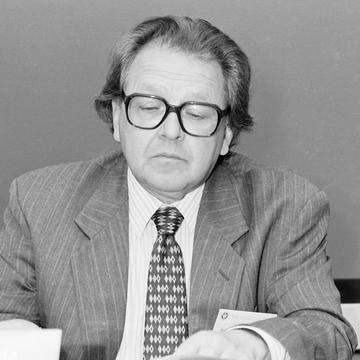Sir George Radda CBE FMedSci FRS
Sir George Charles Radda CBE FRS (Hungarian: György Károly Radda; 9 June 1936 – 13 September 2024) was a Hungarian-British biochemist. George Radda came as a refugee from Hungary. After being interviewed by Oxford Professors in Vienna, he was selected to study in Oxford. He arrived in the UK with a Red Cross flight, and he was recruited by Merton College as an undergraduate. He joined the second year of Chemistry with very poor English and took finals a year later. His examiners realised his difficulty with English, and after his papers were remarked, awarded him with a first class honours degree. His Part II (Masters) research was in Physical Organic Chemistry and he continued research in this area for his DPhil. After a postdoc in California, Berkley with Professor Melvin Calvin he returned to Oxford. He became departmental demonstrator in Biochemistry from 1964-66, when Sir Hans Krebs was the Head of the Department.

Sir George Radda CBE FMedSci FRS - credit: https://commons.wikimedia.org
In 1966 George was appointed as a University Lecturer in Biochemistry. His research interests were the structure and function of enzymes and membranes. He and his group investigated the role of membrane proteins in mitochondrial energy metabolism, particularly how these proteins are involved in oxidative phosphorylation. In 1969, George became part of the enzyme group, the first interdisciplinary research team in Oxford University. This collaborative scientific research involved NMR, Crystallography, Computing, Organic Chemistry, Inorganic Chemistry and Clinical Biochemistry, which the group initially applied to study glycolytic enzymes.
After Rodney Porter became Head of Department, George worked closely with Raymond Dwek, using NMR and paramagnetic probes to study enzyme structure and function, notably phosphorylase A and B. George went on to use phosphorus-31 NMR to study ATP in metabolic process. This enabled him to study ATP dynamics and hence metabolic changes that occur in ischemia, cancer and metabolic diseases. The first clinical application of NMR (nuclear magnetic resonance) in diagnostics, pioneered by George Radda and his team, involved using phosphorus-31 NMR to study muscle metabolism in human patients. In 1981, Radda's group applied this technique to investigate metabolic disorders, such as McArdle’s disease, a condition affecting muscle energy metabolism. This was a breakthrough, as it allowed for the non-invasive observation of biochemical changes in tissues, laying the groundwork for the development of magnetic resonance imaging (MRI) and its use in diagnosing various diseases. In conjunction with Professor David Gadian this pioneering work laid the groundwork for metabolic imaging and the study of bioenergetics in health and disease.
In 1984 George became British Heart Foundation Professor of Molecular Cardiology. In 1991 and until 1996 became the Head of the Biochemistry Department, taken over from Professor Edwin Southern. In 1996 George Radda was elected to the Royal Society and he became Chief Executive of the UK Medical Research Council. In 2003 he returned to the Department as an Emeritus Professor, and his research group under Professor Kieran Clarke moved to the Department of Physiology, Anatomy & Genetics, where George came out of the retirement for 3 years to become the head of department.
George Radda has received numerous awards during his life and made significant contributions to the biochemistry discipline.
We sent our condolences to his wife, Sue Bailey, an ex-member of the Biochemistry Department, and his children, while celebrating George’s remarkable career and contributions to modern biochemistry, bioimaging and medicine.




